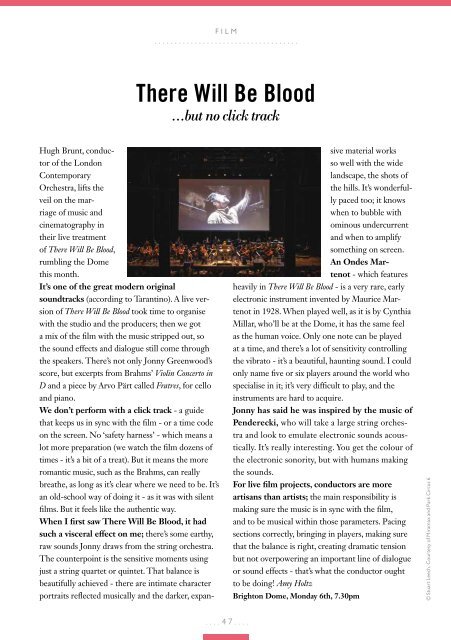Viva Brighton Issue #48 February 2017
Create successful ePaper yourself
Turn your PDF publications into a flip-book with our unique Google optimized e-Paper software.
FILM<br />
....................................<br />
There Will Be Blood<br />
...but no click track<br />
Hugh Brunt, conductor<br />
of the London<br />
Contemporary<br />
Orchestra, lifts the<br />
veil on the marriage<br />
of music and<br />
cinematography in<br />
their live treatment<br />
of There Will Be Blood,<br />
rumbling the Dome<br />
this month.<br />
It’s one of the great modern original<br />
soundtracks (according to Tarantino). A live version<br />
of There Will Be Blood took time to organise<br />
with the studio and the producers; then we got<br />
a mix of the film with the music stripped out, so<br />
the sound effects and dialogue still come through<br />
the speakers. There’s not only Jonny Greenwood’s<br />
score, but excerpts from Brahms’ Violin Concerto in<br />
D and a piece by Arvo Pärt called Fratres, for cello<br />
and piano.<br />
We don’t perform with a click track - a guide<br />
that keeps us in sync with the film - or a time code<br />
on the screen. No ‘safety harness’ - which means a<br />
lot more preparation (we watch the film dozens of<br />
times - it’s a bit of a treat). But it means the more<br />
romantic music, such as the Brahms, can really<br />
breathe, as long as it’s clear where we need to be. It’s<br />
an old-school way of doing it - as it was with silent<br />
films. But it feels like the authentic way.<br />
When I first saw There Will Be Blood, it had<br />
such a visceral effect on me; there’s some earthy,<br />
raw sounds Jonny draws from the string orchestra.<br />
The counterpoint is the sensitive moments using<br />
just a string quartet or quintet. That balance is<br />
beautifully achieved - there are intimate character<br />
portraits reflected musically and the darker, expansive<br />
material works<br />
so well with the wide<br />
landscape, the shots of<br />
the hills. It’s wonderfully<br />
paced too; it knows<br />
when to bubble with<br />
ominous undercurrent<br />
and when to amplify<br />
something on screen.<br />
An Ondes Martenot<br />
- which features<br />
heavily in There Will Be Blood - is a very rare, early<br />
electronic instrument invented by Maurice Martenot<br />
in 1928. When played well, as it is by Cynthia<br />
Millar, who’ll be at the Dome, it has the same feel<br />
as the human voice. Only one note can be played<br />
at a time, and there’s a lot of sensitivity controlling<br />
the vibrato - it’s a beautiful, haunting sound. I could<br />
only name five or six players around the world who<br />
specialise in it; it’s very difficult to play, and the<br />
instruments are hard to acquire.<br />
Jonny has said he was inspired by the music of<br />
Penderecki, who will take a large string orchestra<br />
and look to emulate electronic sounds acoustically.<br />
It’s really interesting. You get the colour of<br />
the electronic sonority, but with humans making<br />
the sounds.<br />
For live film projects, conductors are more<br />
artisans than artists; the main responsibility is<br />
making sure the music is in sync with the film,<br />
and to be musical within those parameters. Pacing<br />
sections correctly, bringing in players, making sure<br />
that the balance is right, creating dramatic tension<br />
but not overpowering an important line of dialogue<br />
or sound effects - that’s what the conductor ought<br />
to be doing! Amy Holtz<br />
<strong>Brighton</strong> Dome, Monday 6th, 7.30pm<br />
© Stuart Leech. Courtesy of Miramax and Park Circus 6<br />
....47....


















